牛津译林版(2019)选修第一册Unit 2 The Universal Language-Extended reading课件(17张PPT)
文档属性
| 名称 | 牛津译林版(2019)选修第一册Unit 2 The Universal Language-Extended reading课件(17张PPT) | 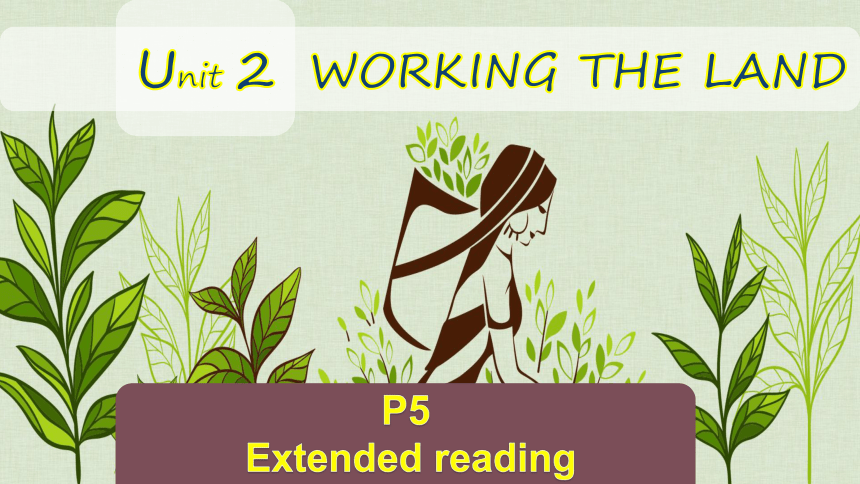 | |
| 格式 | zip | ||
| 文件大小 | 6.6MB | ||
| 资源类型 | 教案 | ||
| 版本资源 | 牛津译林版(2019) | ||
| 科目 | 英语 | ||
| 更新时间 | 2022-04-19 17:30:14 | ||
图片预览

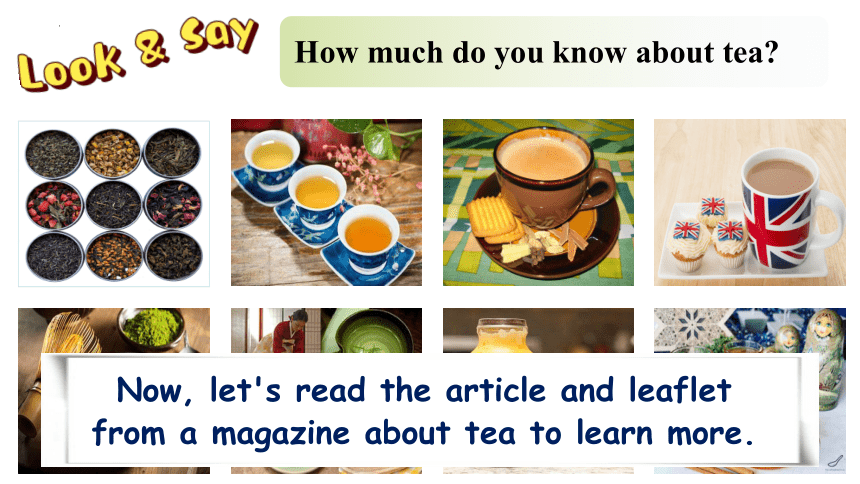
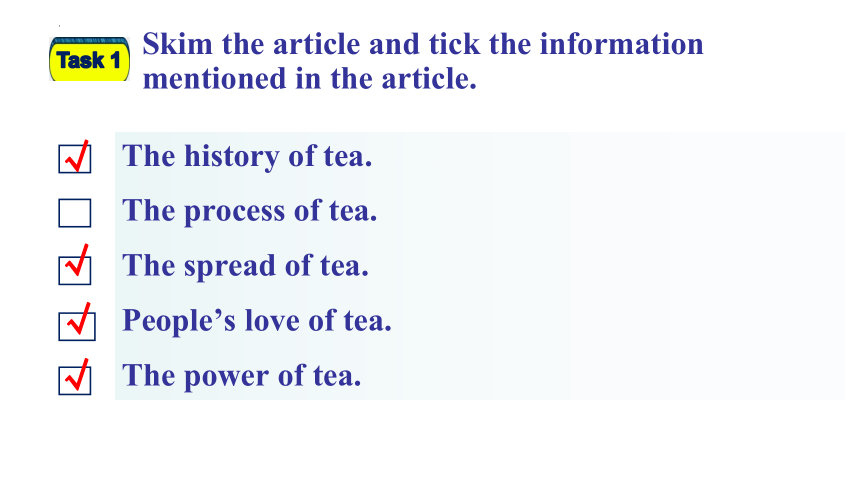
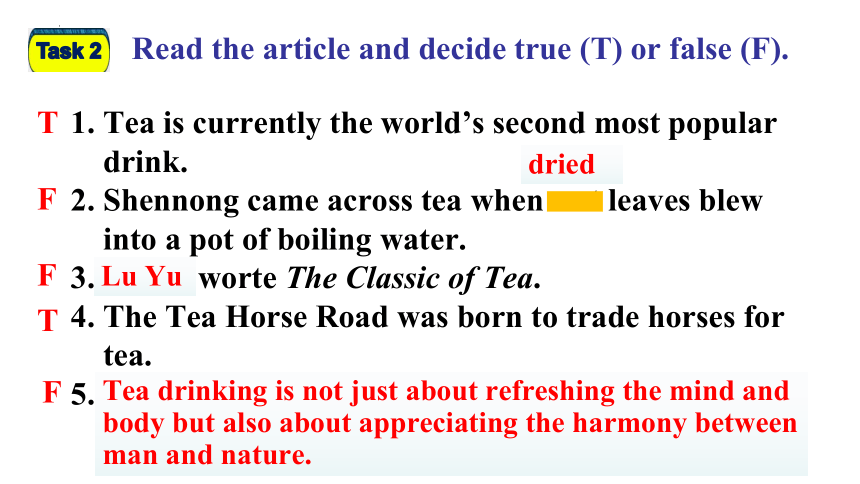
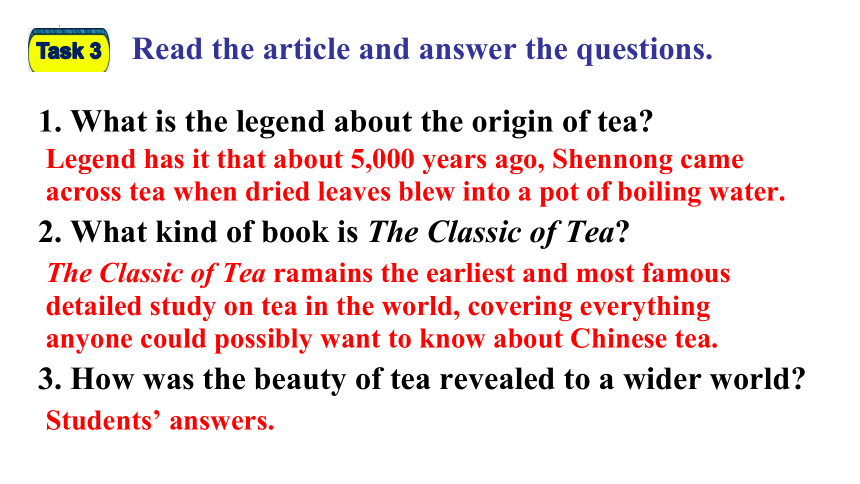
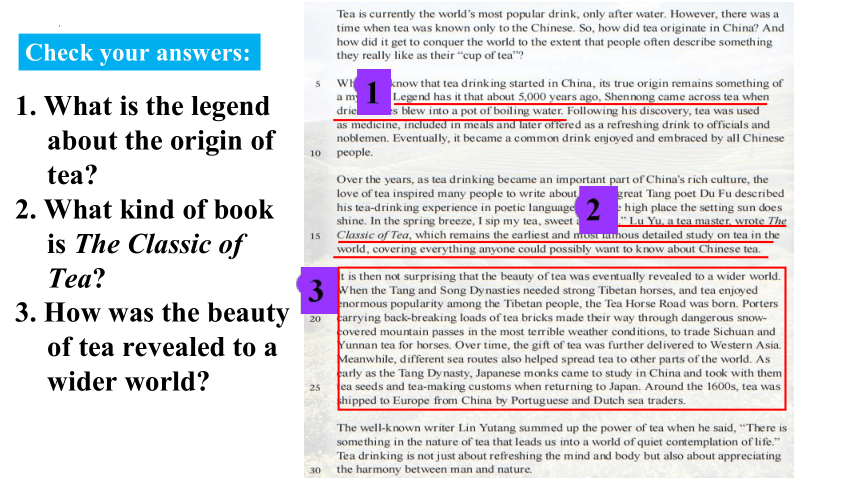

文档简介
(共17张PPT)
WORKING THE LAND
Unit 2
P5
Extended reading
The picture shows all kinds of ______.
Tea
How much do you know about tea
Now, let's read the article and leaflet from a magazine about tea to learn more.
Skim the article and tick the information mentioned in the article.
Task 1
The history of tea.
The process of tea.
The spread of tea.
People’s love of tea.
The power of tea.
√
√
√
√
Read the article and decide true (T) or false (F).
Task 2
1. Tea is currently the world’s second most popular drink.
2. Shennong came across tea when wet leaves blew into a pot of boiling water.
3. Du Fu worte The Classic of Tea.
4. The Tea Horse Road was born to trade horses for tea.
5. Tea drinking is just about refreshing the mind and body.
T
F
F
Tea drinking is not just about refreshing the mind and body but also about appreciating the harmony between man and nature.
T
F
Lu Yu
dried
Read the article and answer the questions.
Task 3
1. What is the legend about the origin of tea
2. What kind of book is The Classic of Tea
3. How was the beauty of tea revealed to a wider world
Legend has it that about 5,000 years ago, Shennong came across tea when dried leaves blew into a pot of boiling water.
The Classic of Tea ramains the earliest and most famous detailed study on tea in the world, covering everything anyone could possibly want to know about Chinese tea.
Students’ answers.
Check your answers:
1. What is the legend about the origin of tea
2. What kind of book is The Classic of Tea
3. How was the beauty of tea revealed to a wider world
What might be appropriate subheadings for the different sections of the leaflet Write them down in the blanks.
Task 4
Subheading 1:
Harvesting tea
Subheading 2:
Processing tea
Subheading 3:
Enjoying tea
Read the leaflet and decide true (T) or false (F).
Task 5
1. China boasts many tea-growing areas, which can be divided into three distinct regions.
2. The region south of the Yangtze River produces the most tea in China.
3. The process of turning tea leaves into the tea we love to drink is very easy.
4. Although there are different types of tea, they may be made from a single tea plant.
T
F
four
F
both complicated and highly technical.
T
Let’s watch a video to learn more about the history of tea.
After reading
analysing, summary, retelling
Lu Yu, a tea master, wrote The Classic of Tea, which remains the earliest and most famous detailed study on tea in the world, covering everything anyone could possibly want to know about Chinese tea.
Lu Yu的同位语
whcih引导的定语从句,修饰先行词The Classic of Tea
非谓语作定语修饰The Classic of Tea
①We are still friends, though, which is good.
②There is a gentleman asking to see you.
不过我们仍然是朋友,这令人感到欣慰。
有一位先生要求见你。
品茶大师陆羽撰写了《茶经》,这是世界上最早、最著名的茶的详细研究,涵盖了任何人可能想了解的关于中国茶的一切。
Sentence analysing for better understanding
P26 A
Write a summary of the magazine article. Use the following ideas to help you.
Coffee is also a drink that enjoys popularity around the world. How is it similar to and different from tea
P26 C
Tea and coffee are both good sources of caffeine and antioxidants(抗氧化剂).
Coffee contains twice as much caffeine as tea, and can give you a more immediate energy boost.
Tea is a genteel(文雅的) beverage requiring preparation and time to sip. The pace is always slow, calm and tranquil, the beverage soothing. On the other hand, the coffee culture can be fast paced and frantic.
…
Possible answers:
Now 2 mins to test our spelling.
Spelling Bee
1. English-Chinese
conquer, legend, nobleman, sip, contemplation, humid, well-drained, maturity, exclusion, cultivation
2. Chinese- English
碰到,偶遇;传说……;总结;有段时间……
When finishing, exchange to see who does the best.
Self-evaluation
各个击破
1. Can you talk about the history of tea
2. Can you talk about how tea comes from hillside to teacup
Search for more information about how coffee is similar to and different from tea.
H
WORKING THE LAND
Unit 2
P5
Extended reading
The picture shows all kinds of ______.
Tea
How much do you know about tea
Now, let's read the article and leaflet from a magazine about tea to learn more.
Skim the article and tick the information mentioned in the article.
Task 1
The history of tea.
The process of tea.
The spread of tea.
People’s love of tea.
The power of tea.
√
√
√
√
Read the article and decide true (T) or false (F).
Task 2
1. Tea is currently the world’s second most popular drink.
2. Shennong came across tea when wet leaves blew into a pot of boiling water.
3. Du Fu worte The Classic of Tea.
4. The Tea Horse Road was born to trade horses for tea.
5. Tea drinking is just about refreshing the mind and body.
T
F
F
Tea drinking is not just about refreshing the mind and body but also about appreciating the harmony between man and nature.
T
F
Lu Yu
dried
Read the article and answer the questions.
Task 3
1. What is the legend about the origin of tea
2. What kind of book is The Classic of Tea
3. How was the beauty of tea revealed to a wider world
Legend has it that about 5,000 years ago, Shennong came across tea when dried leaves blew into a pot of boiling water.
The Classic of Tea ramains the earliest and most famous detailed study on tea in the world, covering everything anyone could possibly want to know about Chinese tea.
Students’ answers.
Check your answers:
1. What is the legend about the origin of tea
2. What kind of book is The Classic of Tea
3. How was the beauty of tea revealed to a wider world
What might be appropriate subheadings for the different sections of the leaflet Write them down in the blanks.
Task 4
Subheading 1:
Harvesting tea
Subheading 2:
Processing tea
Subheading 3:
Enjoying tea
Read the leaflet and decide true (T) or false (F).
Task 5
1. China boasts many tea-growing areas, which can be divided into three distinct regions.
2. The region south of the Yangtze River produces the most tea in China.
3. The process of turning tea leaves into the tea we love to drink is very easy.
4. Although there are different types of tea, they may be made from a single tea plant.
T
F
four
F
both complicated and highly technical.
T
Let’s watch a video to learn more about the history of tea.
After reading
analysing, summary, retelling
Lu Yu, a tea master, wrote The Classic of Tea, which remains the earliest and most famous detailed study on tea in the world, covering everything anyone could possibly want to know about Chinese tea.
Lu Yu的同位语
whcih引导的定语从句,修饰先行词The Classic of Tea
非谓语作定语修饰The Classic of Tea
①We are still friends, though, which is good.
②There is a gentleman asking to see you.
不过我们仍然是朋友,这令人感到欣慰。
有一位先生要求见你。
品茶大师陆羽撰写了《茶经》,这是世界上最早、最著名的茶的详细研究,涵盖了任何人可能想了解的关于中国茶的一切。
Sentence analysing for better understanding
P26 A
Write a summary of the magazine article. Use the following ideas to help you.
Coffee is also a drink that enjoys popularity around the world. How is it similar to and different from tea
P26 C
Tea and coffee are both good sources of caffeine and antioxidants(抗氧化剂).
Coffee contains twice as much caffeine as tea, and can give you a more immediate energy boost.
Tea is a genteel(文雅的) beverage requiring preparation and time to sip. The pace is always slow, calm and tranquil, the beverage soothing. On the other hand, the coffee culture can be fast paced and frantic.
…
Possible answers:
Now 2 mins to test our spelling.
Spelling Bee
1. English-Chinese
conquer, legend, nobleman, sip, contemplation, humid, well-drained, maturity, exclusion, cultivation
2. Chinese- English
碰到,偶遇;传说……;总结;有段时间……
When finishing, exchange to see who does the best.
Self-evaluation
各个击破
1. Can you talk about the history of tea
2. Can you talk about how tea comes from hillside to teacup
Search for more information about how coffee is similar to and different from tea.
H
同课章节目录
- Unit 1 Food matters
- Welcome to the unit
- Reading
- Grammar and usage
- Integrated skills
- Extended reading
- Project
- Unit 2 The Universal Language
- Welcome to the unit
- Reading
- Grammar and usage
- Integrated skills
- Extended reading
- Project
- Unit 3 The art of painting
- Welcome to the unit
- Reading
- Grammar and usage
- Integrated skills
- Extended reading
- Project
- Unit 4 Exploring poetry
- Welcome to the unit
- Reading
- Grammar and usage
- Integrated skills
- Extended reading
- Project
